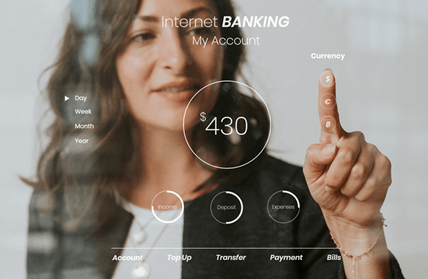Artificial Intelligence for Banks: five trends to watch out for
The banking industry is no stranger to disruption. From digital banking to the explosion of mobile apps, new technologies have reshaped how we manage our finances. Today, thanks to AI technologies, we are witnessing a new era that is bringing significant change to all kinds of banking services.
This article delves into the exciting possibilities AI is bringing to banking. We will examine how AI will impact customer service and loan approvals. We will also acknowledge the significance of responsible implementation. This will create a future that benefits everyone.
To learn about using AI in real-life banking situations, download our ebook on AI for banking.
Five Trends Defining the present of AI in banking
AI is transforming banking into a smarter, more personal experience. Here you will find five key trends driving this revolution, from productivity boosts to personalized financial guidance. Buckle up and get ready to see how AI is shaping the future of your money.
1. Generative AI for banks: much more than a productivity boost
There's a lot of excitement and experimentation around generative AI, with leaders expecting it to change how we work, individually and across society. However, it's important to remember that generative AI isn't a magic solution. It won't work for everything and requires the right strategy, data, and people to be truly effective.
In the banking sector, solutions based on generative AI are expected to increase productivity between 22% and 30%.
This is due to several applications of this technology where it would reduce the amount of time spent on specific tasks such as:
- Supporting sales teams:
At Pragma, we have experienced firsthand how companies in the financial sector can empower their sales teams through generative Artificial Intelligence.
AI-powered chatbots can deliver accurate and robust information to respond to the specific needs of each customer. This technology can be crucial to facilitate the work of sales teams and can also have a significant impact on the quality of the user experience.
This type of solution could increase financial institutions' profits by 6% over the next six years. - Modernization of technological assets
Banks are using generative AI to update legacy systems. This will be a crucial opportunity for organizations trying to reduce technical debt.
Using Large Language Models as an assistant for development projects speeds up the creation of scalable, modern systems. These systems replace monolithic architectures, which are less flexible and require important investments and sometimes cumbersome development efforts for update.
2. Personalization and Life-Centricity
Imagine your banking app managing transactions and providing valuable, tailored advice. This future is closer than you think, with banks transforming their structures to prioritize a more personalized service based on data analysis.
Banks can leverage data and AI to treat each customer as an individual, resulting in a more trusting, productive relationship between them and their customers.
Banks can analyze customer data to understand their needs and offer timely advice and relevant products. This "life-centric" approach fosters trust and loyalty since feeling valued leads to stronger relationships. On the other hand, personalized offers on the digital platform boost conversion and could be key to enhanced brand differentiation.
3. Talent and outsourcing: the keys to timely creation of innovative AI solutions
Banks are investing heavily to secure the ai capable talent they need to maintain leadership in the age of Artificial Intelligence. In the United States and Europe alone, banka employ least 46,000 in AI and data analytics roles.
The race for top AI talent is heating up as banks, and every other companies scramble to leverage AI for growth. While some large banks are building their tech teams, the demand for skilled professionals will likely outstrip supply.
To keep pace and reach the market in a timely manner, outsourcing could be crucial, especially through nearshore partners or companies specialized in providing technology services for banks.
4. Beyond Storage: Cloud based services as AI enablers
Today, driven by the desire to leverage AI and data analytics, businesses within banks are championing the cloud. They recognize that the cloud is not just a storage solution but a whole new operating method - a "cloud-first" mentality.
This shift is leading to several fundamental changes. For example, business leaders are working alongside IT to push for a complete cloud migration. On the other hand, Banks will abandon their on-premise models and build new processes explicitly designed for the cloud.
The cloud journey will take time, but banks are moving past the " why " question and focusing on "how" to achieve a cloud-first future.
5. Regulation: paving the pad to an Open Economy
Artificial Intelligence could be a turning point for bank regulation. We might see a change to a better system that makes the financial industry safer and more competitive.
Thanks to AI, regulators are adopting advanced data analytics to better understand the financial landscape. This allows for more targeted and effective regulations that focus on outcomes, not just processes.
In this scenario, AI can reinforce collaboration between banks and regulators to define critical issues like data sharing. Having a clear set of rules on this issue is essential for implementing an Open Economy model, where, based on user authorization, banks can use large amounts of financial data to create digital ecosystems in which all types of businesses cooperate to provide services based on a deep understanding of user needs.
Pragma has years of experience building digital solutions for banking. Looking for a partner to power your organization with Artificial Intelligence?
Share this
You May Also Like
These Related Stories

US Open Banking Outlook: Adoption, Benefits & Implications
.webp?width=419&height=280&name=imagenes-CEx-olimpica-card%20(1).webp)
This Is How We Used Gen Ai to Increase Sales and Loyalty

Personalization from 360-degree Customer View: Step-by-step Guide
Subscribe to
Pragma Blog
You will receive a monthly selection of our content on Digital Transformation.
